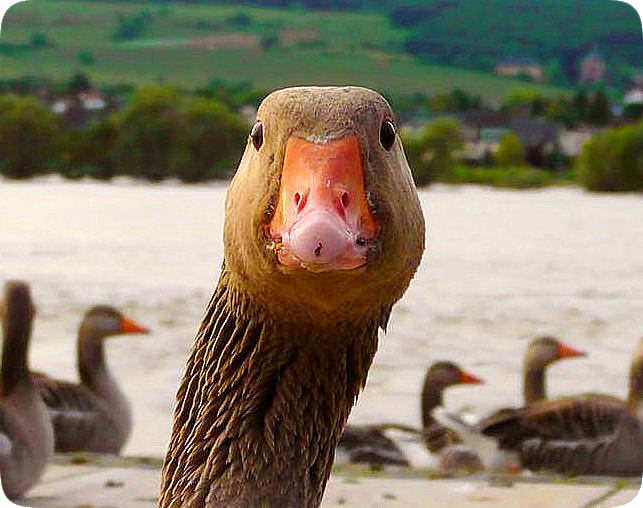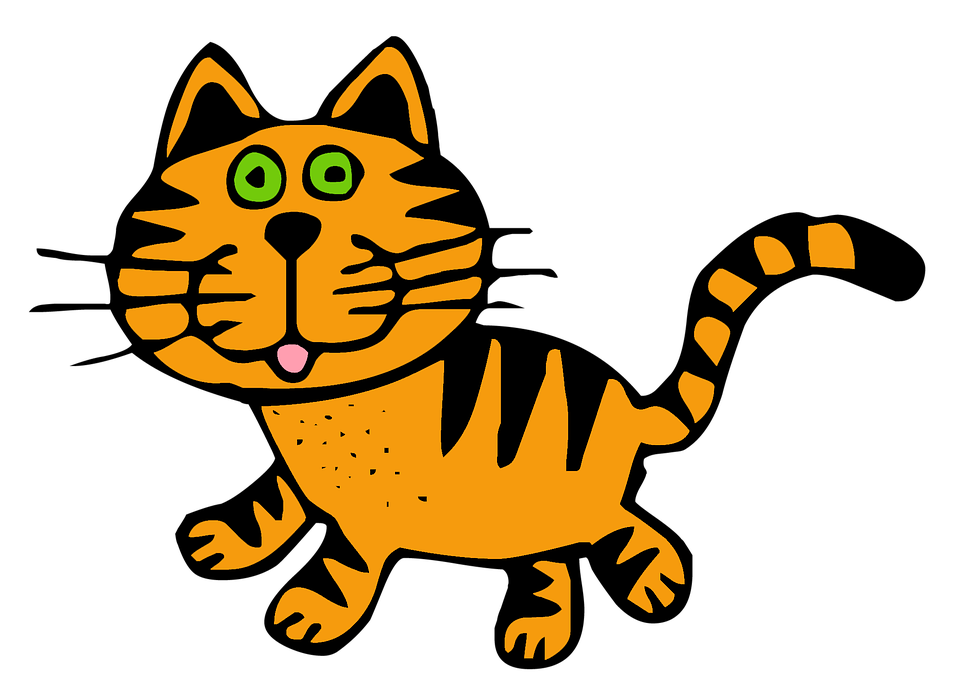A family of ostriches out for a walk in the country . . . yes, life is good . . .
Some people do not take ostriches seriously, as if big birds are somehow a big joke, although these large birds run faster than horses, and male ostriches roar like lions.
The Ostrich Is a Silly Bird
The ostrich is a silly bird
With scarcely any mind.
He often runs so very fast
He leaves himself behind.
And when he gets there, has to stand
And hang about till night,
Without a blessed thing to do
Until he comes in sight.
by Mary E. Wilkins Freeman
Ostriches are unique looking animals with large, feather-covered bodies. They typically have long necks, small wings, large brown eyes, long beaks, and long skinny legs. Adult male ostriches have black feathers with some white on their undersides and tails. Adult female ostriches have light gray-brown feathers. Ostrich chicks have mottled brown and tan fluffy down, and will grow feathers as they mature into adult birds. Their coloration helps them blend in with their surroundings.
Some people do not take ostriches seriously, as if big birds are somehow a big joke, although these large birds run faster than horses, and male ostriches roar like lions.
The Ostrich Is a Silly Bird
The ostrich is a silly bird
With scarcely any mind.
He often runs so very fast
He leaves himself behind.
And when he gets there, has to stand
And hang about till night,
Without a blessed thing to do
Until he comes in sight.
by Mary E. Wilkins Freeman
Ostriches are unique looking animals with large, feather-covered bodies. They typically have long necks, small wings, large brown eyes, long beaks, and long skinny legs. Adult male ostriches have black feathers with some white on their undersides and tails. Adult female ostriches have light gray-brown feathers. Ostrich chicks have mottled brown and tan fluffy down, and will grow feathers as they mature into adult birds. Their coloration helps them blend in with their surroundings.
These ostriches are looking down on you because they are taller than you.
Ostriches are the largest, tallest, and heaviest birds presently living on Earth. They can grow to be up to 2.7 meters (9 feet) tall and can weigh up to 145 kilograms (320 pounds).
Ostrich Facts
- An adult male ostrich is called a cock or a rooster.
- An adult female ostrich is called a hen.
- A young ostrich is called a chick.
- A group of ostriches is called a flock or a troop.
- Ostriches are flightless birds.
- The sounds made by ostriches are called hisses, roars, booms, and grunts.
- Ostrich chicks make a low chirping sound up to about 2 months of age.
- Ostriches naturally live in the wild in Africa.
- Ostriches in the wild can live for up to 40 years.
- Ostriches in captivity can live for 30 to 70 years.
Knock, knock.
Who’s there?
Ostrich.
Ostrich, who?
Just an ostrich, that’s all!
Ostriches live in the woodlands and in the hot, dry savannas of sub-Saharan Africa, which is the part of Africa south of the Sahara desert. Ostriches are particularly well-adapted to the harsh conditions of the desert. In fact, their scientific name, ‘Struthio camelus,’ means ‘camel bird,’ a name given to them perhaps because ostriches can dwell in environments similar to what many camels live in.
In Australia, a number of farm-raised ostriches have escaped and now live in the wild, where they are thriving in conditions similar to their native Africa. These birds could be called feral animals, meaning domesticated animals and descendants of domesticated animals that are living in the wild.
Ostriches have been living on Earth for an estimated 70 to 120 million years. They survive because they are big, tough, smart, fast birds. They can run away from danger, but they also can kick with their legs and feet to protect themselves. Although they can only kick forward, they can kill animals and humans that they perceive as threats, usually with just a single swift kick. Ostriches also have dangerous long beaks to use as weapons. An additional survival strategy that ostriches use is to crouch close to the ground to blend in with their surroundings as a way to escape from danger.
Two women were being shown through the zoo, and their guide halted before the ostriches to explain, “Now this, ladies, is a very unusual bird. It can see very little and can digest practically anything.” “Goodness,” exclaimed one of the women. “Wouldn’t it make an ideal husband?”
Ostriches are omnivores, or animals that eat both plants and animals. They eat grass, leaves, flowers, roots, and other parts of plants. They also eat fruits, seeds, nuts, locusts and other insects, and small animals such as rodents, lizards, and snakes. To help them grind up and digest their food, ostriches eat sand and small pebbles. Ostriches obtain most of their water from the food they eat. They do drink water when they find it, but need to drink only every few days.
Ostriches’ eyes are nearly 5 centimeters (2 inches) wide, making them the largest eyes of any land animal. They have three sets of eyelids to protect them from flying sand and debris.
Ostriches have long necks that allow them to see predators from far away. The submariners’ expression, “Up, periscope!” might come to mind when we consider ostriches. They have long, thin necks atop which are two jumbo-sized eyes; using this periscope-type arrangement, they can extend their sight above much of the uneven terrain and low scrub brush, bushes, and other plants in their surroundings. They can then duck their ‘periscopes’ back down to remain less visible to any dangerous animals.
Floyd: Why does an ostrich have such a long neck?
Lloyd: Because its head is so far from its body.
You may have heard that ostrich brains are smaller than their eyes, and that is true. However, while ostrich brains are about the size of chicken eggs, it is not their brains that you would have to reckon with if you were to encounter a perturbed ostrich. Their large beaks and the sharp claws attached to their powerful legs are what you would need to be focused on. If you should ever find yourself around an agitated or mad ostrich, your best chance of survival may be to drop down onto your stomach and remain still until the ostrich becomes bored and moves on.
Next Thanksgiving, let’s have an ostrich instead of a turkey . . . oh, wait, first we will need an industrial-size oven!
Ostriches are raised on farms for feathers, meat, eggs, and leather. Ostrich feathers can be used to make feather dusters and articles of fashion-wear. Ostrich meat is the leanest of all red meats. Ostrich eggs can be cooked and eaten, and the thick eggshells can be made into decorative items. Ostrich leather can be used to make boots, jackets, hats, and handbags. The crisscrossing fibers within ostrich leather make it very durable.
Madeline: Why don’t ostriches fly?
Clementine: They can’t get past airline security.
Although ostriches cannot fly because they are heavy and have tiny wings, they are built for running, with long legs and strong leg muscles. Ostriches are the fastest runners of all bipedal (two-legged) animals on Earth, capable of moving at up to around 70 kilometers (43 miles) per hour. They can run more than twice as fast as humans. The swiftness of ostriches helps them survive in Africa, where hyenas, leopards, and lions are always on the prowl for prey to eat. The ostriches’ speed allows them to outdistance most predators, with the exception of cheetahs, which can run in short bursts of up to 121 kilometers (75 miles) per hour.
In ancient Egypt, ostriches pulled chariots, which are two-wheeled carts set low to the ground and made for speed, with usually just one or sometimes two riders. While it is possible for people to ride on the backs of ostriches using specially made saddles, the birds are difficult to steer. The tendency for them to be somewhat bird-brained makes ostrich races less common than other types of animal races, such as horse races, camel races, and dog races.
An annual Ostrich Festival is held at Tumbleweed Park in Chandler, Arizona, United States of America. The festival features amusement-park-type rides, foods and beverages, trained animal acts, ostrich races, costumed superheroes, and much more. For information, visit www.ostrichfestival.com.
Ostriches are the largest, tallest, and heaviest birds presently living on Earth. They can grow to be up to 2.7 meters (9 feet) tall and can weigh up to 145 kilograms (320 pounds).
Ostrich Facts
- An adult male ostrich is called a cock or a rooster.
- An adult female ostrich is called a hen.
- A young ostrich is called a chick.
- A group of ostriches is called a flock or a troop.
- Ostriches are flightless birds.
- The sounds made by ostriches are called hisses, roars, booms, and grunts.
- Ostrich chicks make a low chirping sound up to about 2 months of age.
- Ostriches naturally live in the wild in Africa.
- Ostriches in the wild can live for up to 40 years.
- Ostriches in captivity can live for 30 to 70 years.
Knock, knock.
Who’s there?
Ostrich.
Ostrich, who?
Just an ostrich, that’s all!
Ostriches live in the woodlands and in the hot, dry savannas of sub-Saharan Africa, which is the part of Africa south of the Sahara desert. Ostriches are particularly well-adapted to the harsh conditions of the desert. In fact, their scientific name, ‘Struthio camelus,’ means ‘camel bird,’ a name given to them perhaps because ostriches can dwell in environments similar to what many camels live in.
In Australia, a number of farm-raised ostriches have escaped and now live in the wild, where they are thriving in conditions similar to their native Africa. These birds could be called feral animals, meaning domesticated animals and descendants of domesticated animals that are living in the wild.
Ostriches have been living on Earth for an estimated 70 to 120 million years. They survive because they are big, tough, smart, fast birds. They can run away from danger, but they also can kick with their legs and feet to protect themselves. Although they can only kick forward, they can kill animals and humans that they perceive as threats, usually with just a single swift kick. Ostriches also have dangerous long beaks to use as weapons. An additional survival strategy that ostriches use is to crouch close to the ground to blend in with their surroundings as a way to escape from danger.
Two women were being shown through the zoo, and their guide halted before the ostriches to explain, “Now this, ladies, is a very unusual bird. It can see very little and can digest practically anything.” “Goodness,” exclaimed one of the women. “Wouldn’t it make an ideal husband?”
Ostriches are omnivores, or animals that eat both plants and animals. They eat grass, leaves, flowers, roots, and other parts of plants. They also eat fruits, seeds, nuts, locusts and other insects, and small animals such as rodents, lizards, and snakes. To help them grind up and digest their food, ostriches eat sand and small pebbles. Ostriches obtain most of their water from the food they eat. They do drink water when they find it, but need to drink only every few days.
Ostriches’ eyes are nearly 5 centimeters (2 inches) wide, making them the largest eyes of any land animal. They have three sets of eyelids to protect them from flying sand and debris.
Ostriches have long necks that allow them to see predators from far away. The submariners’ expression, “Up, periscope!” might come to mind when we consider ostriches. They have long, thin necks atop which are two jumbo-sized eyes; using this periscope-type arrangement, they can extend their sight above much of the uneven terrain and low scrub brush, bushes, and other plants in their surroundings. They can then duck their ‘periscopes’ back down to remain less visible to any dangerous animals.
Floyd: Why does an ostrich have such a long neck?
Lloyd: Because its head is so far from its body.
You may have heard that ostrich brains are smaller than their eyes, and that is true. However, while ostrich brains are about the size of chicken eggs, it is not their brains that you would have to reckon with if you were to encounter a perturbed ostrich. Their large beaks and the sharp claws attached to their powerful legs are what you would need to be focused on. If you should ever find yourself around an agitated or mad ostrich, your best chance of survival may be to drop down onto your stomach and remain still until the ostrich becomes bored and moves on.
Next Thanksgiving, let’s have an ostrich instead of a turkey . . . oh, wait, first we will need an industrial-size oven!
Ostriches are raised on farms for feathers, meat, eggs, and leather. Ostrich feathers can be used to make feather dusters and articles of fashion-wear. Ostrich meat is the leanest of all red meats. Ostrich eggs can be cooked and eaten, and the thick eggshells can be made into decorative items. Ostrich leather can be used to make boots, jackets, hats, and handbags. The crisscrossing fibers within ostrich leather make it very durable.
Madeline: Why don’t ostriches fly?
Clementine: They can’t get past airline security.
Although ostriches cannot fly because they are heavy and have tiny wings, they are built for running, with long legs and strong leg muscles. Ostriches are the fastest runners of all bipedal (two-legged) animals on Earth, capable of moving at up to around 70 kilometers (43 miles) per hour. They can run more than twice as fast as humans. The swiftness of ostriches helps them survive in Africa, where hyenas, leopards, and lions are always on the prowl for prey to eat. The ostriches’ speed allows them to outdistance most predators, with the exception of cheetahs, which can run in short bursts of up to 121 kilometers (75 miles) per hour.
In ancient Egypt, ostriches pulled chariots, which are two-wheeled carts set low to the ground and made for speed, with usually just one or sometimes two riders. While it is possible for people to ride on the backs of ostriches using specially made saddles, the birds are difficult to steer. The tendency for them to be somewhat bird-brained makes ostrich races less common than other types of animal races, such as horse races, camel races, and dog races.
An annual Ostrich Festival is held at Tumbleweed Park in Chandler, Arizona, United States of America. The festival features amusement-park-type rides, foods and beverages, trained animal acts, ostrich races, costumed superheroes, and much more. For information, visit www.ostrichfestival.com.
This is how life on the Planet of the Ostriches looks.
Ostriches lay the largest bird’s eggs in the world; their oblong eggs are up to 11 centimeters (4.33 inches) long by 18 centimeters (7 inches) in width and weigh 1.3 kilograms (3 pounds). One ostrich egg is equivalent in volume to two dozen chicken eggs.
An ostrich egg takes 90 minutes to become hard-boiled because of its size and the thickness of its shell. Ostrich eggs can be used to make deviled eggs and scrambled eggs, and used in cooking just like chicken eggs. Be sure to adjust your recipes based on their humongous size.
Ostriches have only two toes on each foot, while all other birds have three or four toes. Ostriches often have one claw growing on each foot, on only the inner of the two toes, with their outer toes often being clawless, not unlike the way some humans have almost no toenails on their smallest toes. The claws can be about 7 centimeters (2.76 inches) in length, and are used as cutting and tearing weapons, or to scratch out shallow nests in the ground.
Ozzie: Why did the ostriches walk to the watering hole?
Rich: Because they cannot fly.
Ostriches are social birds that live in nomadic (wandering) groups of typically 5 to 50 members. During the dry season, when rain is less frequent or absent entirely, ostriches gather in large flocks in the vicinity of watering holes. During the rainy season, the large flocks of ostriches break down into smaller flocks, each having one dominant male and about 2 to 5 female ostriches.
‘Ostrich’ can be pronounced as ôs'trĭch, ŏs'trĭch, ôs'trĭj, or ŏs'trĭj. If you know of any other ways it can be pronounced, please let us know.
No one has ever asked ostriches why they stick their heads in the sand, or if this is even true. Possible reasons they might do so include searching for water, trying to find lost contact lenses, or looking for buried pirate treasure. Others claim that ostriches do not bury their heads in the sand at all - it only appears so because when they cannot run from danger, they flop to the ground and lay still, and the color of their heads blends in with the sand.
Baby Ostrich: Mama, do ostriches really bury their heads in the sand when they are scared?
Mama Ostrich: Of course not, dear. That is just an old myth.
Baby Ostrich: Then why do I have dirt in my ears?
Ostriches Quiz
- Are you an ostrich?
- If you were an ostrich, where would you most likely be right now?
- Do ostriches build nests in trees the way many other types of birds do?
- How do ostriches deal with predators, or animals that want to eat them?
- Is your neighborhood zoned for ostriches, if you wanted to start an ostrich ranch?
- By volume, how many chicken eggs are equivalent to one ostrich egg?
“Ostrich, noun: A large bird to which (for its sins, doubtless) nature has denied that hinder toe in which so many pious naturalists have seen a conspicuous evidence of design. The absence of a good working pair of wings is no defect, for, as has been ingeniously pointed out, the ostrich does not fly.” -Ambrose Bierce
Ostriches are tall birds, but this topic is a little short on ostrich fun stuff. We will add more to it in the future. Thanks for visiting MFOL! and have a very funny day!
Ostriches lay the largest bird’s eggs in the world; their oblong eggs are up to 11 centimeters (4.33 inches) long by 18 centimeters (7 inches) in width and weigh 1.3 kilograms (3 pounds). One ostrich egg is equivalent in volume to two dozen chicken eggs.
An ostrich egg takes 90 minutes to become hard-boiled because of its size and the thickness of its shell. Ostrich eggs can be used to make deviled eggs and scrambled eggs, and used in cooking just like chicken eggs. Be sure to adjust your recipes based on their humongous size.
Ostriches have only two toes on each foot, while all other birds have three or four toes. Ostriches often have one claw growing on each foot, on only the inner of the two toes, with their outer toes often being clawless, not unlike the way some humans have almost no toenails on their smallest toes. The claws can be about 7 centimeters (2.76 inches) in length, and are used as cutting and tearing weapons, or to scratch out shallow nests in the ground.
Ozzie: Why did the ostriches walk to the watering hole?
Rich: Because they cannot fly.
Ostriches are social birds that live in nomadic (wandering) groups of typically 5 to 50 members. During the dry season, when rain is less frequent or absent entirely, ostriches gather in large flocks in the vicinity of watering holes. During the rainy season, the large flocks of ostriches break down into smaller flocks, each having one dominant male and about 2 to 5 female ostriches.
‘Ostrich’ can be pronounced as ôs'trĭch, ŏs'trĭch, ôs'trĭj, or ŏs'trĭj. If you know of any other ways it can be pronounced, please let us know.
No one has ever asked ostriches why they stick their heads in the sand, or if this is even true. Possible reasons they might do so include searching for water, trying to find lost contact lenses, or looking for buried pirate treasure. Others claim that ostriches do not bury their heads in the sand at all - it only appears so because when they cannot run from danger, they flop to the ground and lay still, and the color of their heads blends in with the sand.
Baby Ostrich: Mama, do ostriches really bury their heads in the sand when they are scared?
Mama Ostrich: Of course not, dear. That is just an old myth.
Baby Ostrich: Then why do I have dirt in my ears?
Ostriches Quiz
- Are you an ostrich?
- If you were an ostrich, where would you most likely be right now?
- Do ostriches build nests in trees the way many other types of birds do?
- How do ostriches deal with predators, or animals that want to eat them?
- Is your neighborhood zoned for ostriches, if you wanted to start an ostrich ranch?
- By volume, how many chicken eggs are equivalent to one ostrich egg?
“Ostrich, noun: A large bird to which (for its sins, doubtless) nature has denied that hinder toe in which so many pious naturalists have seen a conspicuous evidence of design. The absence of a good working pair of wings is no defect, for, as has been ingeniously pointed out, the ostrich does not fly.” -Ambrose Bierce
Ostriches are tall birds, but this topic is a little short on ostrich fun stuff. We will add more to it in the future. Thanks for visiting MFOL! and have a very funny day!

































































































































